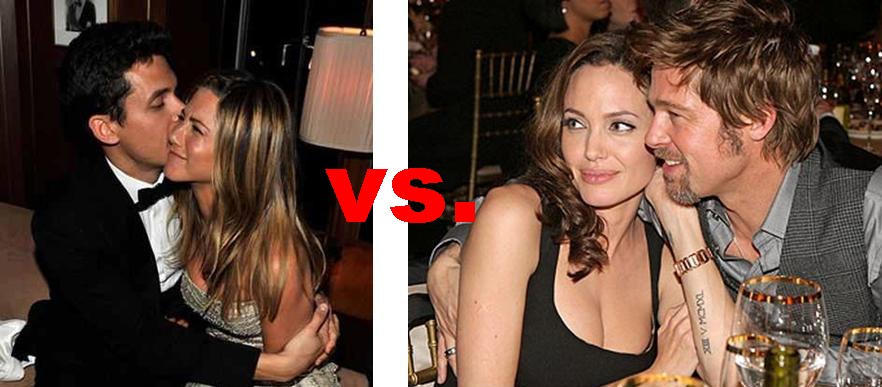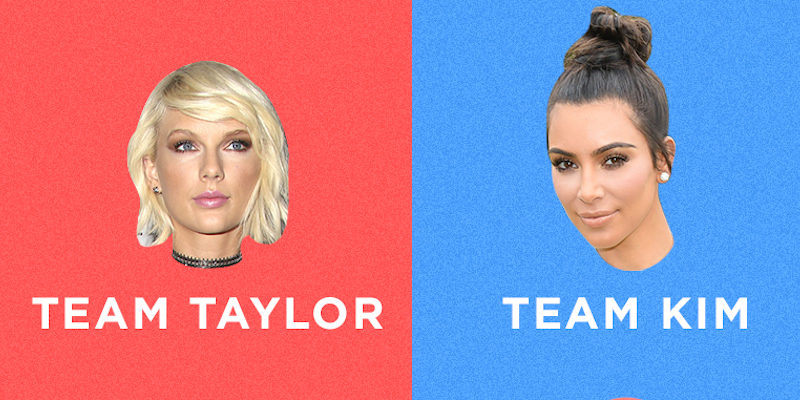She said she said
The celebrity feud is a cornerstone of our Hollywood obsessed culture. Recent classics like Kim vs. Taylor and Angelina vs. Jennifer often pose the question, which side are you on? But the real question is—why do we have to pick sides? The answer lies in society’ s obsession with celebrity culture and their questionable portrayals of the celebrities in the media.
Why do I know that Kim Kardashian’ s daughter, North West, had a ballet class in Hollywood last week and gave the paparazzi the stink eye? It’ s because celebrity news is everywhere: on television, the Internet, social media and advertisements. It’ s inescapable, whether we really care about what they’ re doing or not. An unfortunate product of this is‘ thefemale celebrity feud’ which is not a new concept—but contains underlying sexism that very few of the gossip sites that push these feuds try to delve into.
Back in 2005 Jennifer Aniston and Brad Pitt, once considered one of Hollywood’ s major power couples, divorced. Instantly, Angelina Jolie was thrown into the mix because Brad and Angelina had recently made the movie Mr. and Mrs. Smith together and soon started a relationship after Brad’ s divorce. In September 2016, it was announced that Angelina filed for divorce, citing irreconcilable differences. This separation sparked countless stories and a set of memes declaring that Jennifer Aniston had finally ‘ won’ and had the last word, pushing the narrative of woman vs. woman. But why exactly does the media feel the need to constantly pit women against each other?
In an interview with The Hollywood Reporter, Jennifer Aniston made her only comment about what happened in 2005 by stating, “ Nobody did anything wrong. You know what I mean? It was just like, sometimes things [happen]. If the world only could just stop with the stupid, soap-opera bullshit. There’ s no story.” Aniston insists that a story that the media has constructed does not exist, but publications continued for over a decade to push this same narrative.
Why exactly does this happen? Well, for one, sexism is still prominent in the industry. Where is Brad in all of this? He was an active participant in both relationships, yet Jennifer and Angelina are the only ones with the public’ s focus. Since Jennifer and Brad’ s divorce, the two women have been constantly pitted against each other because of the archetypes that the media believes that women should fall into. Angelina is portrayed as the “ other woman” , the one who tore apart a marriage and thus, didn’ t display the qualities of being a “ nice, homely woman.” Jennifer, on the other hand, is portrayed as the “ damsel in distress,” pushed away from her husband to live life as a single woman after he allegedly cheated on her. This inherent sexism exists within the media because of ridiculous societal standards for women. Celebrity culture is solely focused on placing celebrities in roles for our viewing pleasure, even though it has been proven time and time again that they do not abide by our conventional labels for the most part.

In the case of Kim Kardashian and Taylor Swift, sexism played out a little differently. The feud started when Kanye West, Kim’ s husband, releases the song “ Famous” featuring the lines: “ I feel like me and Taylor might still have sex/ Why? I made that bitch famous.” Taylor accuses Kanye of trying to undercut her success, and noted that she had no idea that the song would include the lyrics. In an interview with GQ, Kim states, “ [Taylor] totally knew that [“ Famous” ] was coming out. She wanted to all of a sudden act like she didn’ t.” Kim eventually releases video evidence in which Kanye is seen and heard having a conversation with Taylor about the lyrics for “ Famous” . However, Taylor later comments in an Instagram post that she took offense to the term “ that bitch” , and that he never mentioned that that term would be
included. Kim reveals that the reason she got involved was because she was tired of Taylor consistently “ playing the victim” , and that even though she didn’ t know about the words “ that bitch” being used, she had denied ever having a conversation with Kanye. This was obviously proven to be false.
These feuds between successful female celebrities are created because of our unrealistic behavioural expectations for women. The media usually portrays Taylor as an “ all-American girl,” until they tear her down and accuse her of dating too many men — and criticise her for writing songs about them afterwards. In contrast, Kim Kardashian is mostly known as “ famous for being famous.” She is attacked for being too sexy and fame obsessed in that she will do anything for attention.
But, Kim and Taylor adhere to the sexist standards that the media have set upon them. Taylor, playing into the media’ s views of her as a “ good girl”, blatantly denies any knowledge of the song, thus trying to keep up the image that the media has set for her. Kim, notorious for speaking her mind and seeking dramatic confrontations for her reality show, does exactly that and calls out Taylor purposely on television screens across America. The media is not the only one to blame here; sexism exists in the media industry and in celebrity culture partially because individuals adhere to standards that society sets for them.
So, why are we so concerned with female celebrity feuds? It’ s because some of us are obsessed with trying to idealize celebrities. These women — Jennifer Aniston, Angelina Jolie, Kim Kardashian, and Taylor Swift, are all people. Living, breathing people, with thoughts and feelings. We have to consider how the media is portraying these women and how our viewership only strengthens the sexism that exists in popular culture. Most importantly, we have to consider what this sexism against public figures means for creating norms for sexism against women around the country and the archetypes they are then placed in as a result.
Images courtesy of Google Images
